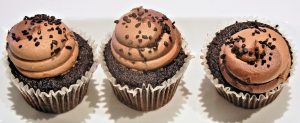Obstacle & Desire in Fiction

A hot topic of conversation between this year’s 7 writers enrolled in my Monthly Mentorship program has to do deciphering what our characters actually want. From there, it’s up to the writer to decide how desire manifests externally and internally.
I love talking about this craft concept, so let’s start with a really simple example: Jamal is in line for coffee and cannot resist the temptation of also ordering a cupcake. It’s the last cupcake and he’s set on having it, but the woman in line ahead of him orders it, robbing him of his treat. This is an external manifestation of an internal desire. At first glance, the internal desire is quite simple and direct–a craving for something sweet, decadent, and maybe even a little forbidden. In our short stories, there needs to be a character-driven reason for just about everything, and for Jamal, that includes the cupcake. For instance, if the cupcake purchase happens on page 2, and when the story ends on page 20, if readers aren’t sure why that cupcake had to be in Jamal’s story, it probably never belonged in the first place.
But maybe on page 4 we get a few lines of backstory about Jamal, indicating that he’s a middle child, largely overshadowed by his showy, basketball star brother, and his insanely bright kid sister. Sure, they’re all adults now, but Jamal can’t help but wonder, as he’s sitting in L.A. traffic commuting home from his job as a sales rep, how things might have turned out differently. If only he’d known what to do with himself between all those weekends his family hit the road for the older brother’s travel games. If only he’d had something to throw himself into as he waited after school for his sister to go to the talented and gifted meetings for STEM hopefuls.
Jamal’s story will continue, of course, and it won’t have anything directly to do with the cupcake or his early years. There will be some other pressing matter with a ticking clock–a deadline at work, a forgotten favor for a neighbor, a decision he has to make about whether or not to RSVP to a friend’s wedding even though he can’t really afford the flight–all carrying the main narrative of the story forward. But at each turn in that main narrative, Jamal will come face to face with the desire for something sweet, something decadent, something maybe even a little forbidden. It won’t likely come in the same external form again (a cupcake), but however it comes, it will be an external expression of the same, even more intense, internal desire.
In time, the reader will see that a cupcake is never just a cupcake, of course, and for Jamal, a cupcake is actually about his deep-seeded desire to be chosen. To be special. To be the thing that’s irresistable, even if it’s also a bit over the top. Maybe he makes his deadline at work, but his report goes relatively unnoticed by the senior sales reps because one of Jamal’s colleagues—an overachiever, say—turned in such a comprehensive report, anything Jamal added was rendered moot. And maybe the favor Jamal forgot to do for his neighbor slipped his mind in the first place because Jamal, in truth, doesn’t really like the neighbor. The neighbor is always complaining, never really adding to the world in any positive way, and they don’t have anything in common anyway. (Hello, irony!) And possibly, Jamal can’t decide about the RSVP to his friend’s wedding not because he can’t really afford the flight, but because he’s flabbergasted that he wasn’t chosen to be Best Man, and feels put out because of this.
At each turn in the main narrative, these obstacles—however minor (nobody dies, after all; no one wrecks their Porsche)—force Jamal to face the truth of his desire again and again, as if he’s running into the same wall and can’t find a way through. Until he does, of course, at the story’s climax and resolution. (Or maybe he never does, which can also be a climax of its own—a final faliure, a final instance of proof that Jamal will never change and is, in fact, fated to remain unchosen, mediocre, and untempting for the rest of his life.)
Jamal’s case might seem relatively straightforward in the opening pages of the story, but it eventually enters complex psychological territory. But what’s a writer to do when her character doesn’t know what it wants? We may write unique similes and have stellar prose. We might evoke new, powerful worlds with vivid detail. Our characters could have humorous word choice or hold interesting jobs. But if we’ve got characters who don’t know what they want, or we have circumstances without correlating obstacles, we don’t really have a story on our hands.
Next week, I’ll be interviewing Christine Sneed, author of The Virginity of Famous Men, about just this kind of quandary, and more. What if we, the writers, can’t tell what our characters want? How do we mine or own drafts for clues? Or how to we decide what to change, so that our drafts have a chance at becoming a full-fledged, believable narratives?
Obstacle and desire are key concepts in flash form writing as well—because we only have 1-3 pages to convey the inner workings of a character’s desires, as well as depict how that plays out in the external world. If you’d like tips and prompts about how to achieve this efficiently in your own work, start the free trial or full ecourse here.


This is very thought-provoking, Katey. The cupcake analogy is so easy to understand! Thanks!
Glad it helped!!!